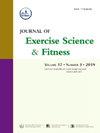单侧训练和双侧训练之间的训练量设置对运动成绩的影响:系统回顾和荟萃分析
IF 2.4
2区 医学
Q2 SPORT SCIENCES
引用次数: 0
摘要
单侧/双侧维度指的是一个动作是由身体的一侧单独完成还是同时涉及到两侧。单侧训练(UT)和双侧训练(BT)已被证明可以提高运动成绩。然而,单侧训练和双侧训练在训练量设置上存在差异,了解它们的特点对于优化训练方案和提高竞技水平至关重要。目的:探讨单侧训练和双侧训练的训练量设置对运动员运动成绩(肌肉力量、跳跃成绩、冲刺时间和转向时间)的影响;研究测试指标、训练频率和训练方案对运动员运动成绩的调节作用。方法于2024年6月5日在PubMed、Medline、Cochrane Library、EBSCOhost和Web of Science (Core Collection)中进行检索,并于2025年4月17日更新。纳入的研究是随机对照试验,研究UT与BT对运动员运动成绩的影响。通过三水平荟萃分析模型,使用标准化平均差异[Hedges' g (g)]总结每个结果的合并效应,并使用亚组分析来探索调节因子。使用GRADE方法评估证据的确定性。结果共纳入9项高质量随机对照试验,涉及225名运动员。结果表明,无论训练量是否相同,UT和BT对运动成绩的提高均无显著差异(g = 0.20 [-1.56, 1.15], I2-2 = 77.8%;I2-3 = 0.0%,低分级)或当UT体积为BT的两倍时(- 0.04 [-0.14,0.06],I2-2 = 93.8%;I2-3 = 0.0%,中等等级)。当UT和BT的训练量相同时,测试项目、训练频率或训练方案对运动成绩的影响没有显著调节。单侧测试指标(g = - 0.84)和双侧测试指标(g = - 0.90)均未显示显著改善。每周训练两次(g = - 0.16)和每周训练三次(g = - 0.19)之间无显著差异。同样,在进行增强式训练(g = - 0.16)和另一次增强式训练(g = - 0.19)之间也没有显著差异。当UT量是BT量的两倍时,测试项目可能会显著调节UT量,但训练频率和训练方案可能不会显著调节UT量。单侧测试指标(g = - 0.39)和双侧测试指标(g = 0.64)均显示出显著改善。每周训练两次(g = - 0.14)与每周训练三次(g = 0.13)之间仍无显著差异。此外,在进行增强训练(g = - 0.01)和另一次增强训练(g = - 0.21)之间没有显著差异。结论单侧训练和双侧训练之间的训练量设置对运动员的运动成绩没有显著影响。测试指标可能是重要的调节因素,而训练频率和训练协议可能不是重要的调节因素。普洛斯彼罗registrationCRD42024545511。本文章由计算机程序翻译,如有差异,请以英文原文为准。

Impact of training volume settings between unilateral training and bilateral training on athletic performance: A systematic review and meta-analysis
Background
The unilateral/bilateral dimension refers to whether an action is performed by one side of the body alone or involves both sides simultaneously. Unilateral training (UT) and bilateral training (BT) have been shown to enhance athletic performance. However, there are differences in training volume settings between unilateral and bilateral training, making it essential to understand their characteristics for optimizing training protocols and improving competitive level.
Objective
This systematic review aimed to: 1) explore the effects of training volume settings between unilateral training and bilateral training on improvements in athletic performance (muscle strength, jump performance, sprint time, and change of direction time), and 2) investigate the moderating effects on testing metrics, training frequency, and training protocol on athletic performance.
Methods
Searches were conducted in PubMed, Medline, Cochrane Library, EBSCOhost, and Web of Science (Core Collection) on June 5, 2024, and updated on April 17, 2025. Included studies were randomized controlled trials that investigated the effects of UT versus BT on athletic performance in athlete. Pooled effects for each outcome were summarized using Standardized Mean Difference [Hedges' g (g)] through a three-level meta-analysis model, and subgroup analyses were used to explore moderators. The certainty of evidence was assessed using the GRADE approach.
Results
A total of nine high-quality randomized controlled trials were included, involving 225 athletes. The results showed that there was no significant difference in improving athletic performance whether the training volume of UT and BT was the same (g = 0.20 [-1.56, 1.15], I2-2 = 77.8 %; I2-3 = 0.0 %, low GRADE) or when the UT volume was twice that of BT (−0.04 [-0.14, 0.06], I2-2 = 93.8 %; I2-3 = 0.0 %, moderate GRADE). When the training volumes of UT and BT were the same, the impact on athletic performance was not significantly moderated by test items, training frequency, or training protocols. Neither unilateral test metrics (g = −0.84) nor bilateral test metrics (g = −0.90) showed significant improvement. There was no significant difference between training twice a week (g = −0.16) and training three times a week (g = −0.19). Similarly, there was no significant difference between conducting plyometric training (g = −0.16) and another instance of plyometric training (g = −0.19). When the UT volume was twice that of BT, it might be significantly moderated by test items, but training frequency and training protocols were likely not significant moderators. Unilateral test metrics (g = −0.39) and bilateral test metrics (g = 0.64) both showed significant improvements. There was still no significant difference between training twice a week (g = −0.14) and training three times a week (g = 0.13). Furthermore, there was no significant difference between conducting plyometric training (g = −0.01) and another instance of plyometric training (g = −0.21).
Conclusion
The training volume settings between unilateral and bilateral training may not have a significant impact on athletic performance. The testing metrics might be the significant moderating factors, whereas training frequency and training protocol are likely not significant moderators.
Prospero registration
CRD42024545511.
求助全文
通过发布文献求助,成功后即可免费获取论文全文。
去求助
来源期刊
CiteScore
5.10
自引率
3.60%
发文量
54
审稿时长
31 days
期刊介绍:
The Journal of Exercise Science and Fitness is the official peer-reviewed journal of The Society of Chinese Scholars on Exercise Physiology and Fitness (SCSEPF), the Physical Fitness Association of Hong Kong, China (HKPFA), and the Hong Kong Association of Sports Medicine and Sports Science (HKASMSS). It is published twice a year, in June and December, by Elsevier.
The Journal accepts original investigations, comprehensive reviews, case studies and short communications on current topics in exercise science, physical fitness and physical education.

 求助内容:
求助内容: 应助结果提醒方式:
应助结果提醒方式:


